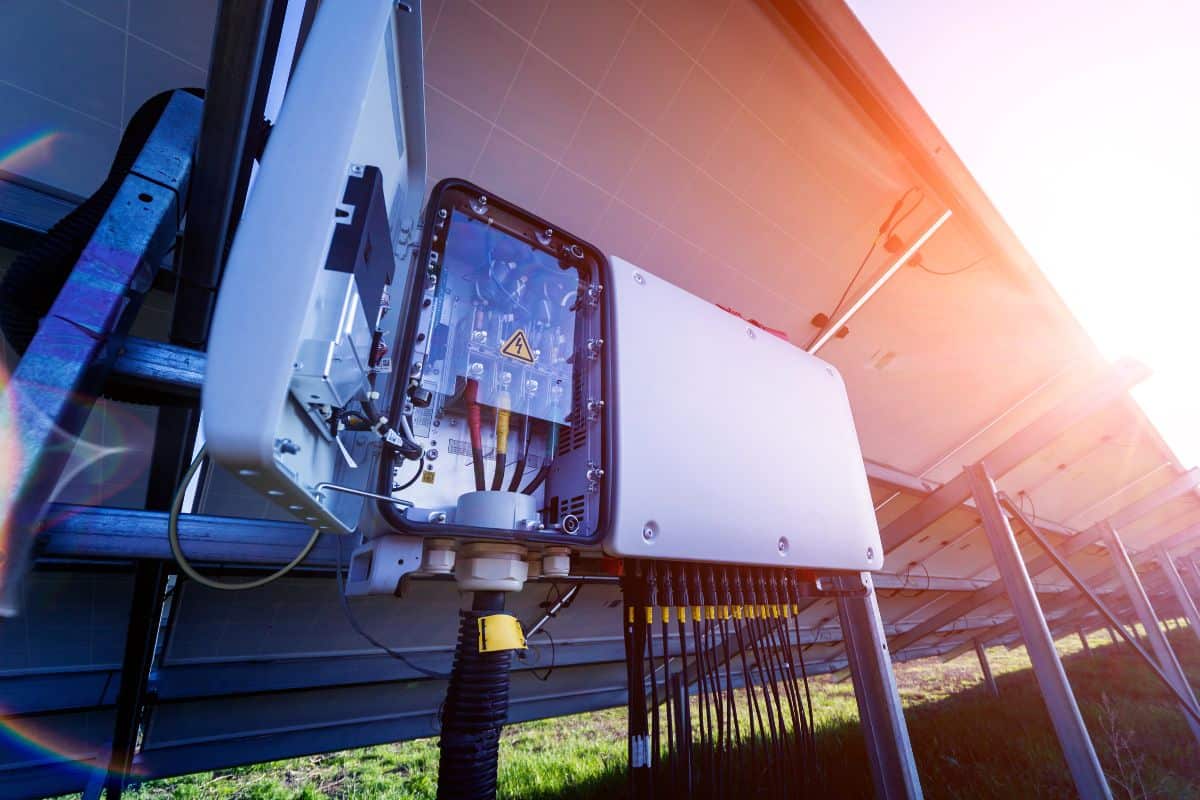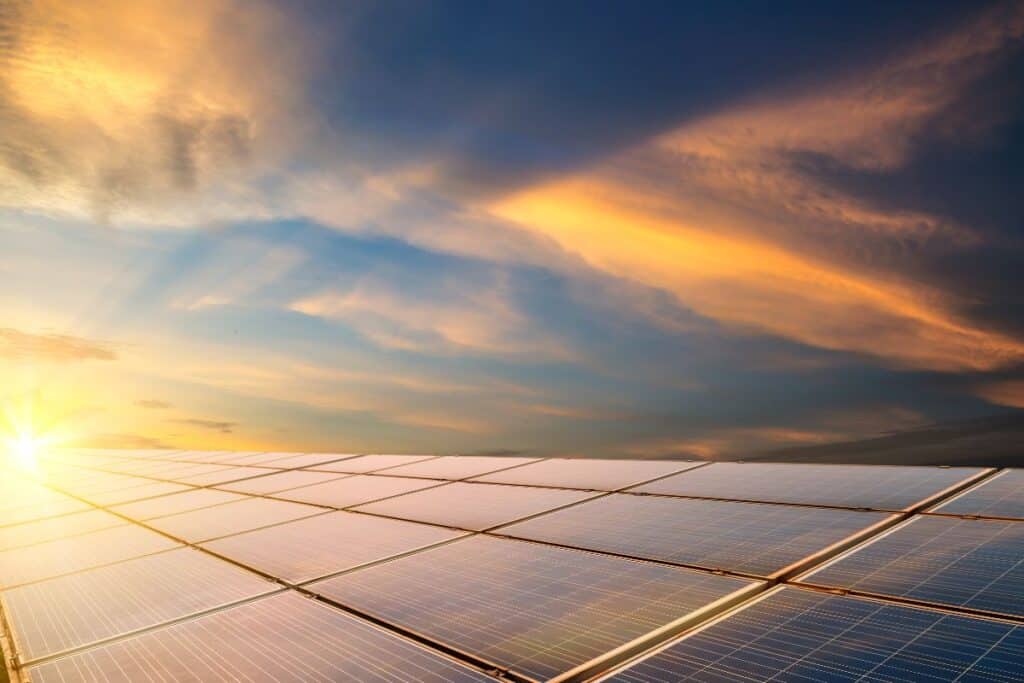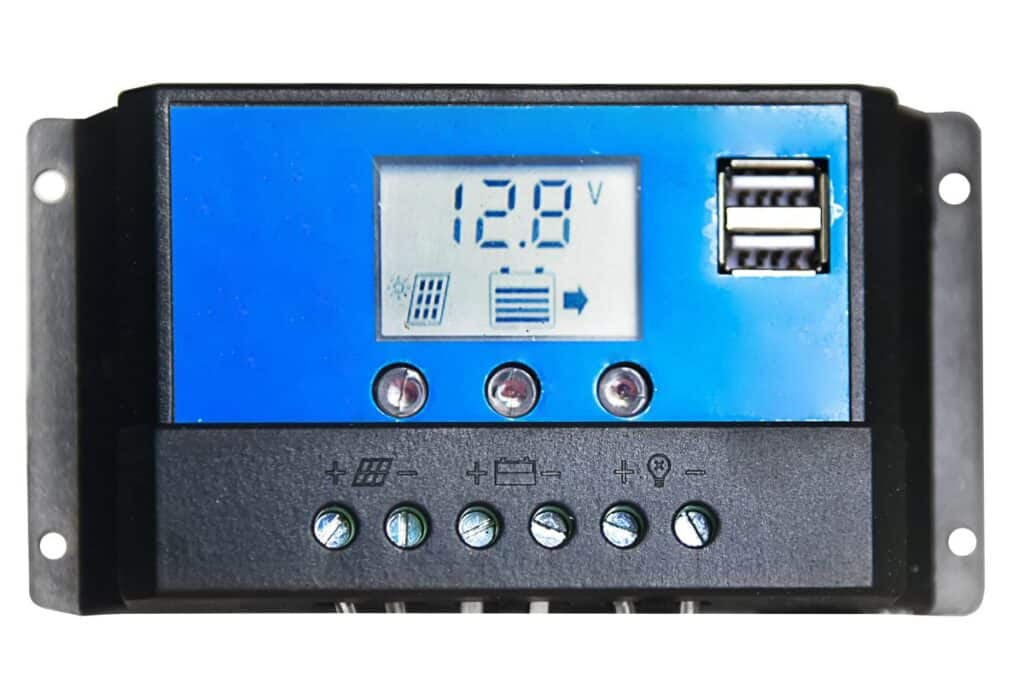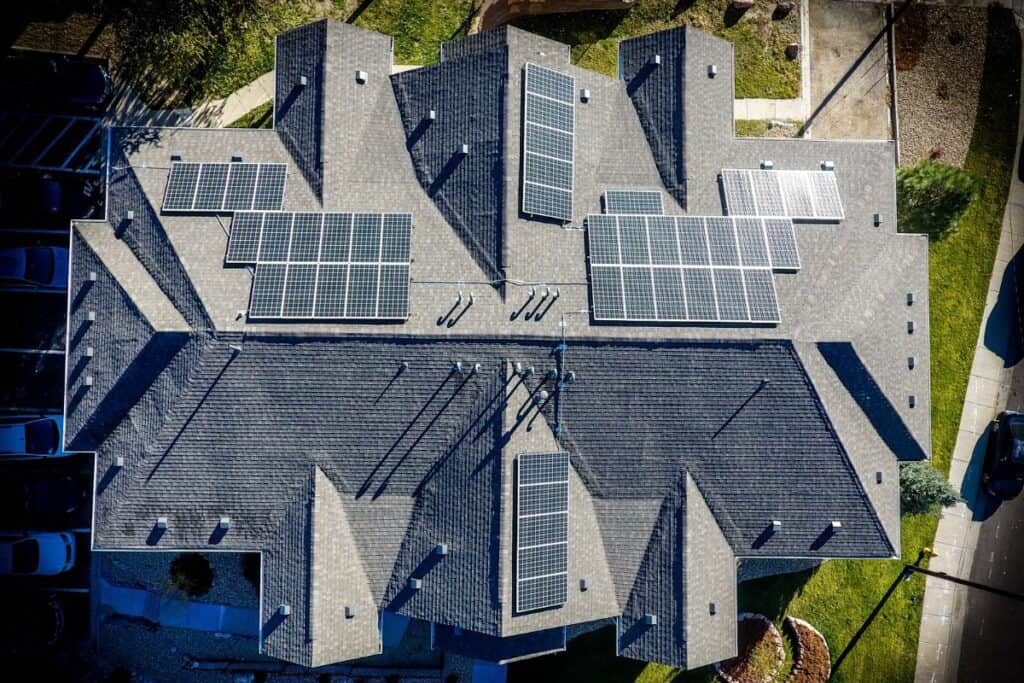Are you looking to demystify the complexities of solar inverters? If so, you’re in the right place. There are 4 different types of solar inverters and they play a crucial role in any solar energy system.
They convert the variable direct current (DC) output of solar panels into a utility-frequency alternating current (AC) that can be fed into your home or back into the electric grid.
In our journey to fully harness the sun’s power, we’ll delve into the different types of solar inverters.
We’ll discuss their operations, strengths, and weaknesses, providing you with the knowledge you need to make an informed decision about your solar power system.

String Inverters
We start with the most common type – the string inverter. String inverters connect solar panels in a series, forming a ‘string’. Energy flows from the panels to the inverter, which then converts and delivers it to your home or the grid. These inverters are cost-effective and straightforward to install. However, their weakness lies in how they handle shade; if a single panel underperforms, it can affect the performance of the whole string.
Microinverters
Next up, we have microinverters. Unlike string inverters, each solar panel in your system gets a dedicated micro inverter. This approach eliminates the problem associated with shaded panels affecting the entire string. Even if one panel underperforms, the others won’t be affected. While they come with higher upfront costs, they are often more efficient and durable.
Power Optimizers
Serving as a middle ground between string and microinverters, we have power optimizers. Like microinverters, each panel has its own power optimizer. They condition the DC electricity at the panel to mitigate any inefficiencies before sending it to a centralized string inverter for conversion to AC. This hybrid approach provides some of the benefits of microinverters without the hefty price tag.
Battery Inverters
Lastly, we have battery inverters, an essential component of solar-plus-storage systems. They convert the DC energy stored in your battery into AC energy for use in your home. This allows you to utilize solar energy even when the sun isn’t shining, providing a consistent power supply.
When choosing the right inverter, consider your system’s size, your budget, the amount of shading on your property, and your future needs.
Let’s dig into each one in a bit more detail and figure out which one is best for you and your solar needs.
How Does a String Inverter Work?
Let’s first dive into string inverters. What exactly are they, and how do it help turn sunlight into usable energy?
A string inverter is a type of solar inverter that works by connecting several solar panels in a series to form a ‘string’. The inverter then converts the direct current (DC) power generated by these solar panels into alternating current (AC) power.
But how does this process happen?
First, the solar panels, all lined up in your ‘string’, absorb sunlight and convert it into DC electricity. This DC electricity, however, cannot be used directly by most household appliances or be fed into the power grid as-is. That’s where our string inverter comes in.
The string inverter takes the combined DC output from your solar panels and converts it into AC electricity. AC is the standard used by the electricity grid and most household appliances. This conversion is crucial in making the energy harnessed by your solar panels usable.
To dive a bit deeper, the inverter’s conversion process involves what’s known as “switching.”
Through rapid on and off switching, the string inverter changes the DC current’s direction, effectively transforming it into AC.
While string inverters are often lauded for their simplicity and cost-effectiveness, it’s important to note one particular downside.
If a single panel in the string is shaded or malfunctions, it reduces the efficiency of the entire string.
Think of it as a chain: if one link is weak, the strength of the whole chain is compromised. This happens because the current generated by all the panels in the string has to flow through the same path. Therefore, if one panel underperforms, it limits the current throughput of the entire string.
However, this downside shouldn’t necessarily discourage you from using string inverters. In fact, in situations with little to no shading and where panels are positioned optimally, string inverters perform exceptionally well.
When are String Inverters the best choice?
String inverters are typically ideal for solar installations where the solar panels are subject to uniform conditions.
In other words, they’re perfect if your solar panels are all installed on a single, unshaded plane with a similar orientation, like a large, south-facing roof with little to no shading. This is because if even a single panel in the string is shaded or facing a different direction, it can significantly reduce the efficiency of the entire string.

In terms of cost, string inverters are usually the most affordable type of solar inverter. They’re simpler devices, so they cost less to manufacture and install than other types of inverters.
If you’re working with a tight budget, a string inverter might be the best choice for you.
String inverters are also known for their reliability.
They’ve been around for longer than other types of inverters, and their technology is well-tested.
In addition, they usually require less maintenance than other inverters because there’s only one inverter for the whole system, rather than one for each panel.
Let’s next look at microinverters…
From Sunlight to Socket: The Inner Workings of Microinverters
Before figuring out if a mciroinverter is right for you, let’s look at exactly what it is.
A microinverter, as the name implies, is a small inverter designed to work with a single solar panel. Unlike string inverters, which connect several panels in a series, microinverters are installed on each solar panel. This setup allows them to convert the direct current (DC) generated by individual panels into alternating current (AC) right at the source. But let’s delve deeper into how this process unfolds.
Each solar panel equipped with a microinverter absorbs sunlight, transforming it into DC electricity. The attached microinverter then immediately converts this DC electricity into AC electricity. This is the type of electricity that’s compatible with the grid and most home appliances. The immediate, panel-level conversion process maximizes the efficiency of each solar panel in your system.
This conversion process involves “switching,” similar to string inverters. The microinverter switches the DC current on and off rapidly, effectively reversing its direction and turning it into an AC current.
One of the primary advantages of microinverters is their ability to maximize the output of each individual solar panel. If one panel is underperforming due to shading or malfunctions, it doesn’t affect the performance of the other panels.
This is unlike string inverters, where the entire string’s performance can be hampered by one underperforming panel. Therefore, if your property experiences uneven shading, microinverters could offer a more effective solution.
On the flip side, microinverters do come with a higher upfront cost compared to string inverters. This is due to the requirement of an inverter for each solar panel. However, this cost may be offset by the higher efficiency and the potential for increased energy production.
Microinverters are an exciting technology in the world of solar energy.
Their panel-level optimization can significantly improve the efficiency of your solar energy system, especially in situations where shading is a concern
So now let’s look at when it is best to use microconverters.
Who are microinverters best for?
Microinverters are the best choice for you if your solar installation has varied panel conditions, you’re planning to expand your system in the future, or you’re willing to invest a bit more upfront for potentially greater energy production and long-term savings.
Microinverters can be an excellent choice for solar installations where the panels are subject to varying conditions.
For example, if your panels are spread out across multiple roof faces with different orientations or if your property experiences uneven shading throughout the day, microinverters could offer an ideal solution.
They ensure that each panel performs at its maximum capacity, regardless of the conditions affecting the other panels.
While microinverters do come with a higher upfront cost compared to string inverters, this cost can often be offset over time.
Thanks to the panel-level optimization that microinverters provide, they can potentially increase your system’s overall energy production. In the long run, this increased efficiency can translate into higher savings on your energy bills.
Additionally, microinverters are a great fit for those planning to expand their solar energy system in the future.
With microinverters, you can add more panels one at a time as your budget or energy needs increase.
This modularity is a unique advantage that isn’t available with string inverters, which require all panels to be added at once to form a new ‘string’.
Let’s next look at power optimizers and exactly how they work.
The Function and Mechanism of Power Optimizers
What are power optimizers, and how do they contribute to making solar energy usable for your home?
A power optimizer is a device that optimizes the energy output of individual solar panels and works in conjunction with a string inverter. It combines the benefits of both string inverters and microinverters, providing an efficient and cost-effective solution.
But how does this process work you may ask?
In a system using power optimizers, each solar panel is equipped with its own optimizer. The optimizer “conditions” the direct current (DC) from the solar panel, boosting its voltage while reducing its current.
This optimizes the DC electricity before it’s sent to a central string inverter for conversion into alternating current (AC), the kind of electricity your household appliances and the grid use.
This optimization process is achieved through what’s known as “maximum power point tracking” (MPPT). The power optimizer continuously adjusts the voltage and current to find the maximum power point, enhancing the panel’s efficiency.
One of the significant advantages of power optimizers is their ability to mitigate the shading issue that often affects systems using string inverters.
Since each panel has its own optimizer, an underperforming or shaded panel does not affect the performance of the others. This way, the power optimizers ensure that each panel operates at its highest efficiency, without impacting the others.
In terms of cost, power optimizers strike a middle ground between string inverters and microinverters.
They provide some of the benefits of microinverters, such as panel-level optimization, without the associated high costs. However, they’re usually more expensive than traditional string inverters.

Who are power optimizers best for?
power optimizers could be the right choice for you if your solar installation experiences varying panel conditions, you plan to expand your system over time, or you are looking for a balance between cost and efficiency. They provide a unique middle ground in the inverter market, combining the best of both worlds.
Power optimizers are ideal if your solar panels face varied conditions.
If your panels are installed on different roof planes, face different orientations, or experience partial shading, power optimizers can ensure each panel operates at its maximum potential, irrespective of others. In other words, they offer the flexibility of microinverters without their high cost.
Regarding cost, power optimizers are usually more expensive than string inverters but less expensive than microinverters.
If you want the benefits of panel-level optimization without the higher upfront cost associated with microinverters, power optimizers might be a good fit.
In addition, power optimizers can be an excellent choice if you are planning to expand your solar power system in the future.
Like microinverters, power optimizers offer the flexibility of adding panels one at a time. So, as your energy needs grow, you can increase your system’s capacity gradually.
In conclusion, power optimizers can be a valuable addition to your solar energy system, providing a balance between cost and efficiency.
They enable each solar panel to perform at its best, ensuring you get the maximum benefit from your system.
It’s important to assess your specific circumstances, including your budget, energy needs, and the amount of shading your property experiences, when deciding whether power optimizers are the right fit for your system.

Let’s now look at battery inverters and how they work.
The Role and Operation of Battery Inverters
Battery inverters, sometimes referred to as bidirectional or hybrid inverters, are a key component in solar-plus-storage systems. They work in conjunction with a battery to store excess solar energy, which can be used later when the sun isn’t shining. But let’s dive deeper into this process.
During the day, your solar panels absorb sunlight and convert it into direct current (DC) electricity.
This DC electricity is then converted into alternating current (AC) by an inverter for immediate use in your home.
However, if your solar panels produce more electricity than your home needs at the moment, this surplus energy needs to be stored for later use.
Here’s where the battery inverter comes into play. The surplus AC power is converted back into DC by the battery inverter to be stored in a battery.
When your solar panels are not producing enough electricity, such as at night or during a cloudy day, the battery inverter reconverts the stored DC power back into AC power for use in your home.
Battery inverters are vital in maximizing the use of solar energy, allowing for energy independence and protection against power outages.
In addition, in some regions, they enable homeowners to participate in energy demand response and time-of-use programs, potentially saving money and contributing to grid stability.
However, it’s important to note that installing a solar-plus-storage system can be more expensive than a standard solar setup due to the added cost of the battery and battery inverter.
Additionally, not all homes may require a battery storage system.
Your specific energy needs, location, and the reliability of your local power grid are factors to consider when deciding if a battery inverter is the right choice for you.
Who is a battery inverter best for?
Solar power has revolutionized the way we generate and consume electricity. And battery inverters, with their ability to store and supply solar power on demand, are an integral part of this transformation.
But who is a battery inverter best for, and what considerations should guide this decision?
A battery inverter is the best choice for you if you desire increased energy independence, live in an area with an unreliable grid, or want to take advantage of time-of-use rates or demand response programs.
Battery inverters, a key component in solar-plus-storage systems, allow you to store surplus solar energy for later use. This means you can still use solar power when the sun isn’t shining. This ability makes battery inverters ideal for those looking to achieve greater energy independence and protect against power outages.
If you live in an area with unreliable grid electricity, a battery inverter can provide consistent power by storing excess solar energy during the day for use at night or during grid outages. In other words, a battery inverter system allows you to have power when you need it most.
Battery inverters are also perfect for those looking to maximize their use of solar energy.
Instead of sending excess solar energy back to the grid, you can store it for your use, reducing your reliance on the grid and potentially saving on energy costs.
In addition, battery inverters can be a great option if your utility company offers time-of-use rates or demand response programs.
In these cases, you can store solar energy when the sun is shining, and use it during peak times when electricity rates are highest.
However, it’s important to note that battery inverters, along with the necessary battery storage system, can add significant costs to your solar installation.
Therefore, they’re best for those willing to make a larger upfront investment for increased energy independence and potential long-term savings.
So in conclusion, battery inverters can provide a solution for those looking to maximize their use of solar energy and increase their energy independence.
As always, it’s recommended to consult with a solar power professional who can help determine if a battery inverter and storage system meet your specific needs and circumstances.
